Contents
Apple and pear trees are traditionally the most common fruit crops in Our Country. Although, in terms of winter hardiness, pear trees are only in fourth place. In addition to apple trees, they are also ahead of plums and cherries. True, a hundred years ago, pears in Our Country were called 10-20-meter giants with a huge crown, but with hard and not very tasty fruits. At present, with the advent of a large number of tasty and productive varieties with rather large fruits, it seems that a new southern culture has come to gardens. And although they still could not get ahead of plum and cherry in terms of winter hardiness, most modern pear varieties still withstand frosts down to -26 ° -28 ° C.
In addition, many modern varieties are distinguished by earlier dates for the entry of trees into fruiting. Previously, pears began to bear fruit no earlier than 5-6 years after planting. Now, many varieties of pears begin to bear fruit already in the third or fourth year.
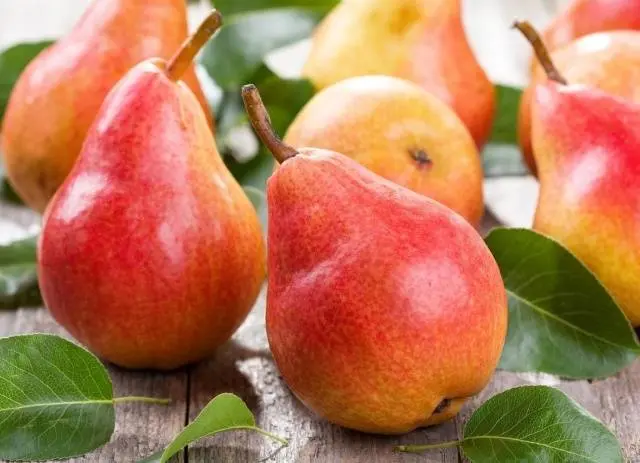
Among modern pears, varieties of foreign origin stand out. The Santa Maria pear is a typical example of this variety. Of course, they are not well adapted to the climatic and weather conditions of most regions of Our Country. But for residents of regions south of Voronezh, we can safely recommend this pear for planting.
Variety description
This variety is fraught with many mysteries, which are not always possible to solve due to its foreign origin. Firstly, the Santa Maria variety was bred in Italy by the breeder A. Moretinni by crossing two varieties: the famous old variety Williams (or otherwise Duchess summer) and Koschia. Naturally, this variety has not yet managed to get into the State Register of Breeding Achievements.
But in the database of the All- Research Institute of Fruit Crop Breeding, there is a pear variety called Bere early Moretinni, the description of which also confirms that it was obtained by A. Moretinni by crossing varieties Williams and Koschia. This pear variety is early summer, that is, it ripens in late July – early August. And according to the description of the Santa Maria pear, it is a typical autumn variety with ripening dates in September. True, some foreign sources indicate that in the countries of southern Europe and in Turkey, the fruits of this variety ripen at the end of July. Apparently, the timing of the ripening of the Italian Santa Maria pear has undergone serious changes, having fallen into the rather harsh climatic conditions of Our Country.
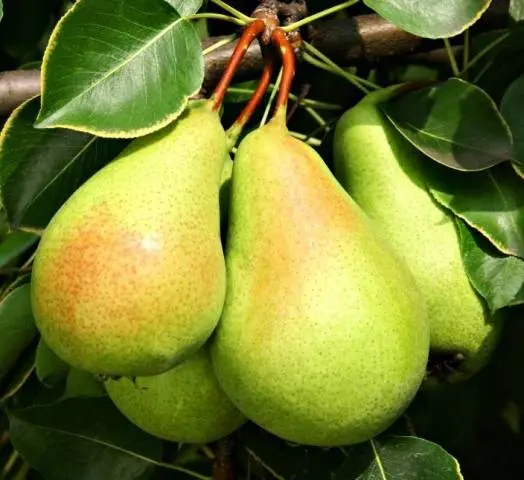
Apparently, these two varieties are sisters with very similar characteristics. However, this occurs in pear breeding, for example, the Chudesnitsa, Feeriya and Nika varieties were obtained from the same parents.
Santa Maria pear trees can be classified as medium-sized, but due to their good compatibility with quince, this variety is often grafted onto a quince rootstock. As a result, the height of fruit-bearing trees decreases, and the timing of the first fruiting, on the contrary, is approaching. So, the first fruits from the trees of this variety can be obtained already in the third year after planting.
The trees of this variety are characterized by a compact, spherical crown.
The variety is partially self-fertile. It is able to bear fruit normally without the additional help of pollinating trees. Nevertheless, to obtain stable and high yields, the following varieties of pears can be recommended as pollinators:
- Abbe Vettel;
- William;
- Thigh.
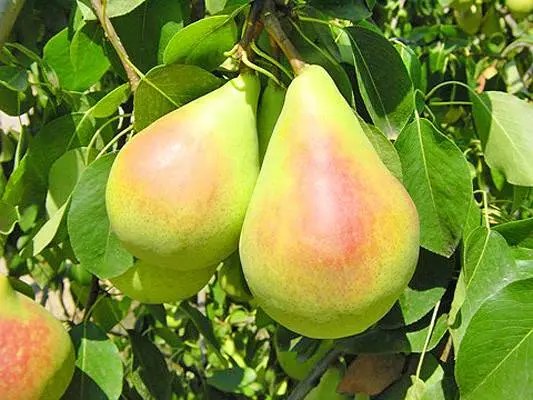
The Santa Maria variety has a high yield, from 50 to 120 kg of delicious pears can be easily removed from one adult tree.
In addition, in the description of the variety, it is stated that the Santa Maria pear is resistant to many unfavorable growth conditions, to scab and has high winter hardiness. But since there are practically no reviews on this variety, after all, it has recently appeared on sale in Our Country, it is not possible to confirm or refute this information. It is known only according to the Association of Producers of Fruits, Berries and Planting Material (APPYPM) in Our Country that the Santa Maria variety is considered unstable in relation to bacterial burn of fruit crops, or otherwise to bacteriosis. Apparently, and in terms of winter hardiness, it can be recommended for cultivation only in more or less southern regions of Our Country.
Fruit Characteristics
It is not in vain that Santa Maria pear fruits are sold in the most elite supermarkets and retail outlets in Our Country. They really have incomparable external and taste characteristics:
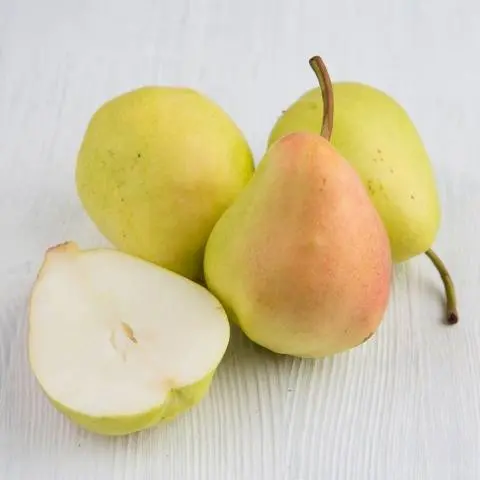
- The shape of the fruit is classic pear-shaped, very regular. Moreover, all the fruits on the tree are uniform in shape and size.
- The size of pears is quite decent, the average weight of one fruit is about 180 grams, but there are also weighing up to 230 grams.
- The skin is thin, smooth, tender, yellow-green in color with small lenticels.
- The pulp is yellow-white, very tender and juicy, oily, graininess is absent, it really “melts in your mouth”.
- The taste of pears is excellent. They are distinguished by a real dessert taste with a light harmonious sourness.
- The appearance of the fruits is also very attractive – when fully ripe, they acquire a beautiful bright lemon hue. And in those places where the sun’s rays directly fall, they leave a pretty blurry pink blush on the pears.
- Fruit preservation is average. According to some sources, Santa Maria pears can be stored for up to two weeks, and according to other sources – up to two months.

- The transportability of pears of this variety is quite acceptable.
- The use of the Santa Maria fruit is truly universal.
The composition of pears includes phytoncides and the most valuable pectin substances. The fruits are very tasty and healthy when fresh, from which you can make a variety of preparations for the winter – jams, jams, marshmallows, candied fruits, jams. In cooking, the unique taste of these pears goes well with cheese, broccoli and many herbs. From the fruits you can prepare bekmes – a unique healing pear honey, and also use them to make various types of cider, kvass, compotes and essences.
Peculiarities of growing
When buying pear seedlings, especially with an open root system, give preference to those that have a large number of small suction roots. It is better if the surface of the roots is protected by a special clay mash, which does not allow the roots to dry out for a period of up to 7 days. In the southern regions, it is optimal to plant a Santa Maria pear in the fall. If you live to the north, then it is better to plan planting a seedling for the spring, so that it has time to acclimatize well in a new place during the warm season.

When planting a pear seedling, make sure that the root neck is at ground level, in no case bury it. Pears do not tolerate strong moisture in the area of the root collar. On the other hand, in order for a seedling to take root well, it needs constant maintenance of moisture not only from the surface, but also at the depth of all the tips of its roots. To do this, a small groove is dug around the trunk in a circle, retreating from the trunk about 70-80 cm, and during the first month after planting, about one bucket of water is poured for each seedling several times a week.
In addition, make sure that no weeds grow in the near-stem circle in the first year, for which the surface of the earth in it must be regularly loosened or mulched with a layer of organic matter 7-10 cm thick.
Top dressing, especially mineral, should not be applied earlier than the pear seedling is two years old. Trees are fed either by spraying branches or by watering in the same groove along the perimeter of the crown of the seedling.
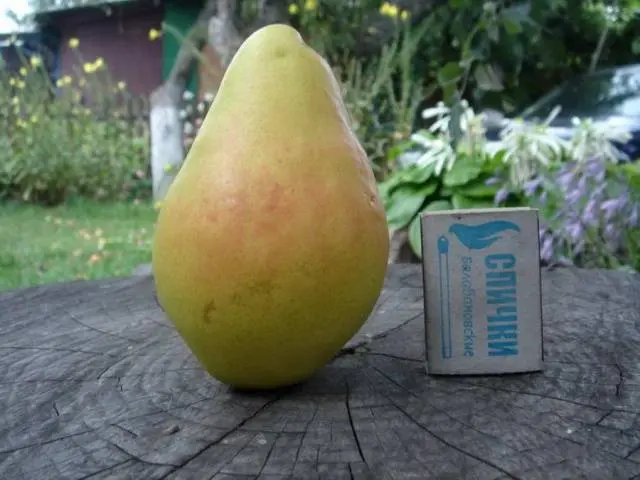
Reviews of gardeners
Since the Santa Maria pear variety has recently appeared in our country, gardeners have not yet had time to get to know it closely. In addition, it is often confused with the pear variety of the Belarusian selection “Prosto Maria”, which is somewhat similar to Santa Maria in many respects, but is more frost-resistant and has a later ripening period.
Conclusion
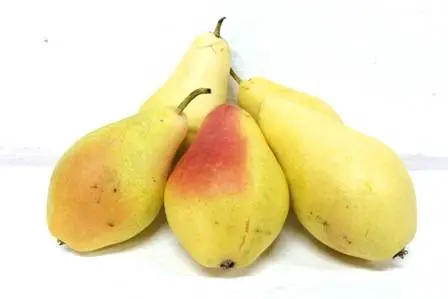
Of course, the fruits of the Santa Maria pear are so attractive in appearance and taste that it is difficult to resist the temptation to plant and grow this variety in your area. But you should remember the southern origin of this variety and correlate the climatic and weather conditions in your area and the ability of Santa Maria to withstand a harsh winter.










